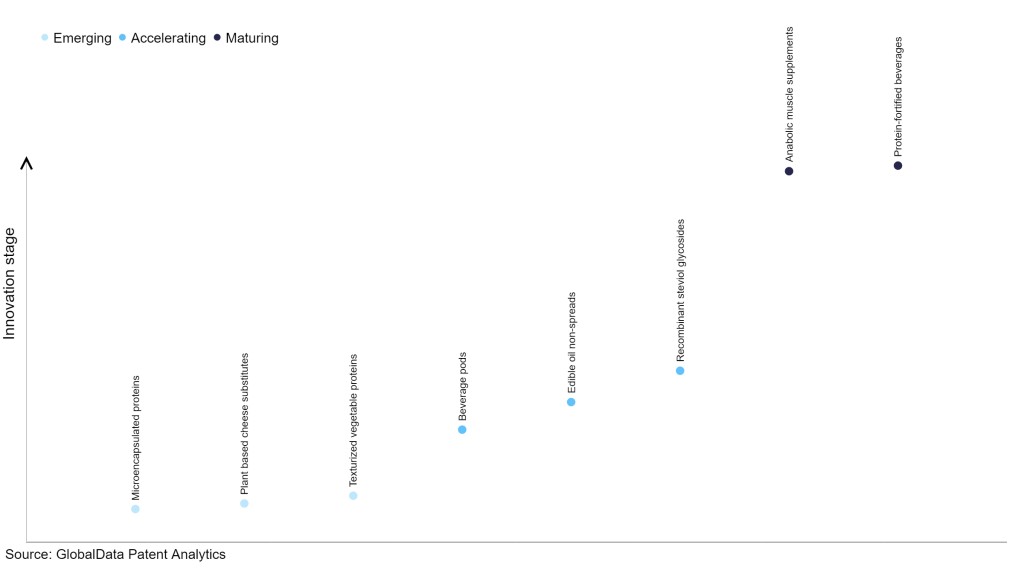The consumer industry continues to be a hotbed of patent innovation. Activity is driven by convenience, environmental sustainability, and health and wellness, as well as the growing importance of food safety and transparency, personalized nutrition, and technologies such as 3D food printer and digital food management. In the last three years alone, there have been over 52,000 patents filed and granted in the consumer industry, according to GlobalData’s report on Innovation in consumer: beverage carbonators. Buy the report here.
However, not all innovations are equal and nor do they follow a constant upward trend. Instead, their evolution takes the form of an S-shaped curve that reflects their typical lifecycle from early emergence to accelerating adoption, before finally stabilizing and reaching maturity.
Identifying where a particular innovation is on this journey, especially those that are in the emerging and accelerating stages, is essential for understanding their current level of adoption and the likely future trajectory and impact they will have.
30+ innovations will shape the consumer industry
According to GlobalData’s Technology Foresights, which plots the S-curve for the consumer industry using innovation intensity models built on over 12,000 patents, there are 30+ innovation areas that will shape the future of the industry.
Within the emerging innovation stage, microencapsulated proteins, plant based cheese substitutes, and texturized vegetable proteins are disruptive technologies that are in the early stages of application and should be tracked closely. Beverage pods, edible oil non-spreads and recombinant steviol glycosides are some of the accelerating innovation areas, where adoption has been steadily increasing. Among maturing innovation areas are anabolic muscle supplements and protein-fortified beverages, which are now well established in the industry.
Innovation S-curve for the consumer industry

Beverage carbonators is a key innovation area in consumer
Beverage carbonation is the process of infusing fizz into soft drinks. Carbonation also creates small bubbles in the beverages.
GlobalData’s analysis also uncovers the companies at the forefront of each innovation area and assesses the potential reach and impact of their patenting activity across different applications and geographies. According to GlobalData, there are 65+ companies, spanning technology vendors, established consumer companies, and up-and-coming start-ups engaged in the development and application of beverage carbonators.
Key players in beverage carbonators – a disruptive innovation in the consumer industry
‘Application diversity’ measures the number of applications identified for each patent. It broadly splits companies into either ‘niche’ or ‘diversified’ innovators.
‘Geographic reach’ refers to the number of countries each patent is registered in. It reflects the breadth of geographic application intended, ranging from ‘global’ to ‘local’.
Patent volumes related to beverage carbonators
Source: GlobalData Patent Analytics
PepsiCo is the leading patent filer in the beverage carbonators space. Some other key patent filers include Samsung Group, Keurig Dr Pepper, and Starbucks. PepsiCo recently made a new addition to its SodaStream line-up of sparkling water makers, which will enable consumers to carbonate flat water at home.
In terms of application diversity, Sun Hung Kai Properties leads the pack, while AB Electrolux and Digal Investments stand in second and third positions, respectively. By means of geographic reach, Middleby holds the top position, followed by PepsiCo and Digal Investments.
Beverage carbonators will potentially become an important aspect in the consumer industry, with the demand for soft drinks expected to increases in the coming years.
To further understand the key themes and technologies disrupting the consumer industry, access GlobalData’s latest thematic research report on Consumer.
Data Insights
From

The gold standard of business intelligence.
Blending expert knowledge with cutting-edge technology, GlobalData’s unrivalled proprietary data will enable you to decode what’s happening in your market. You can make better informed decisions and gain a future-proof advantage over your competitors.



